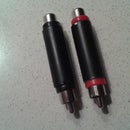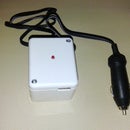Introduction: 12V Lead Battery Linear Charger
INTRODUCTION
Types of chargers:
The standard chargers: they are very simple and cheap, but they are only good for occasional or supervised operations. When working with them it's advisable to have at least one ammeter and two charging positions: low current and high. The ammeter, unlike the voltmeter, does not need high precision for this use.
Automatic battery chargers: simple type that disconnects at the end of the charge. They charge with fairly high currents and disconnect at the end of the charge. Usually at the end of the charge they feel a voltage around 14V.
Automatic battery chargers with maintenance: probably they are the best compromise between cost and functionality. They tend to maintain the voltage at the buffer voltage, therefore about 13.6 V, and supply as much current as the battery requires, up to a maximum value. In practice, this means that at the beginning the charger supplies the maximum current, which will begin to decrease with the increase in battery voltage, until it gradually reaches the maintenance value. The advantage is that the charger can be permanently connected to the battery and will always keep it fully charged without damage. The small defect (bearable in most cases) is that the charge proceeds quite quickly up to about 70%, then it starts to happen more and more slowly up to 100%.
MultiSteps automatic chargers: Usually equipped with a small microprocessor, they charge the battery with a cycle that allows the defect of the constant voltage charger to be eliminated: Initially they use a high current that they maintain until the charge is almost completed, then they switch to a higher current. low up to 100% of the charge, i.e. even exceeding 13.6 V (let's say up to 14V), then they switch to the maintenance current with a low current and the voltage at about 13.6 V.
These obviously are the best because they bring the battery to 100% in the shortest possible time, but they are also the most expensive.
Step 1: Charging a Standard Lead Battery (Fig. B)
When planning to charge a discharged battery you have to consider different parameters.
The most important are: first, the ambient temperature because it influences the charging voltage; second the battery capacity (Ah) and third the actual conditions of it, that is if it reached a sulfation process (it depends but usually it begins under 10.6-10.8V, or about 1.75V per cell), lacking of acidic solution, oxidation of the electrodes, presence of swelling in the pack, etc.
If the battery is in good condition, it has not been stored for a long time, and has a voltage> 10.8V, you can proceed with recharging, bearing in mind that starting from zero it is better to set a voltage at the power supply not over 13.6-13.8V. This should bring the battery to approximately 75-80% charge. A higher voltage or 14.2-14.6V can be performed at a later time (boost procedure) to approach the maximum capacity, 100%.
Both modes must be conducted at constant current within the aforementioned voltage ranges
Step 2: The Project
In the hypothesis of working at 25 ° C, one tenth of the battery capacity must be used, as a number to indicate the charging current for the discharged battery.
E.g. for a 100Ah lead battery the max allowable charge current is 10A. If you go down to a twentieth, so 5A it's even better especially if the battery is particularly discharged. The slower the charging, the more hope you have of recovering a problematic battery. Although there is a limit to electrical recovery. In terms of charging voltage or buffer charge (float, stand-by, trickle) is about 13.7V (at 20 C), for cyclic charge (boost) is 14.5V (at 20 °C).
SEE: Fig. C and D.
I planned a linear PSU based froma simple voltage regulated circuit by a series pass transistor and a feedback network, capable to erogate from about 13 to 15V.
For the purpose I set the output voltage at about 13.8V (25-30 °C of ambient T), operating with a maximum current of 3.2A (constant current) since my lead battery is 60Ah. This allows to perform a quite slow charge (about 5-6% of the battery current).
Step 3: The Power Supply Unit (transformer, Diode Bridge, Capacitors)
For the choice of the transformer I had two options, using a laminated transformer either a toroidal one. I opted for the latter, both for its major efficiency and because I could possibly change the secondary output voltage more easily to my liking.
I wish to obtain a max output current of 5A, even though I limited it to 3.2A as you see later, so power rating of 150VA is more than enough.The transformer's parameters are 230V/50Hz for the primary and 14V/10A for the secondary.
In the event of an hazard short circuit from mains, to prevent the transformer from catching fire it is necessary to use an appropriate fuse, in the range of 1.5-2 times the maximum primary current. Because the high inrush current typical of toroidal transformers it is also a good rule to use type T fuse, so in my case since the current at full load (10A) at the primary is about 0.69A I put a T1.5A fuse. I neglected to add the Ametherm current limiter, which usually is reserved to more powerful toroidal transformers.
The rectifiying part is equally important and it's better just to use an oversized diode bridge. The KBPC3510 (35A/1KV) is a great choice and it's cheap too.
The last choice is addressed to the filter capacitors. Taking into account that as rule of thumb for every ampere into the load I should have ~2000uF capacitor upstream, in this case I oversized a little too going to a pair of 4700uF(50V) caps in series.
Step 4: Design of the Regulating Voltage Circuit
A simple series pass transistor circuit can be satifactorily employed for this purpose for regulating the output voltage. When current demand is quite high, that is about >3A, a better choice for Q1 is a NPN power darlington.
A better regulation of the output voltage can be achieved when a negative feedback is applied thanks to Q3 connected at the base with the voltage divider (R3 and R4). Q3 and R2 form a voltage divider too, and Q3 acts like a variable resistor driven by Ib3 (C.L feedback) which feeding the Q2 base allows less current to flow. Consequentely less current in turn flow into the base of the pass transistor too, Q1. The result is that Q1 is conducting less (decreased Vout).
The feedback fraction in the closed loop of the circuit around Q3 (Fig. 1) is Rf/(Rf + Rh)
Vg (voltage gain) is proportional to the reciprocal of this quantity, hence the close loop gain A' = 1 + Rh/Rf. In terms of voltage it is Vf = Vz + Vd + Vbe, then Vout = A'*Vf = (1 + Rh/Rf)*(Vz + Vd + Vbe). So finally one can get the desired Vout.
It can be observed that the zener diode in series with a reversed silicon diode provides also a proper temperature compensation. In fact, since the 8.2V zener diode has a positive temperature coefficient (this happens when Zd<5V) while the silicon diode has almost an opposite behaviour, with such configuration the voltage drift at output is minimized. This has to be taken into account because the Zd alone, although soldered away from the pass transistor, may be affected from the natural heating process during the (high) current flowing inside the case.
The use of a decoupling capacitor (a small electrolytic is OK) helps further to obtain a clean voltage at the base of the transistor, resulting at the output a virtually noise free voltage. That isn't quite necessary when charging a lead battery but can be useful for other PSU projects.
Of course one could use a known circuit with an opamp employing feedback, but this solution would also increase the circuit complexity.
The disavantage of such this circuit though is that it has no control on the output current, so a completely discharged battery could soak up a huge current quantity and overheat Q1 and DB, in the worst case they would be destroyed too. So a simple current limiter is placed in the circuit by the use of Q4 and Rx. Choosing a proper Rx value one could get several amps, remembering I(out)=0.7/Rx. With the TIP147 one can go up to about 7A, with 2N3055 the safe range is within 5A.
For my goal I limited the current to 3.2A with a 0.22ohm resistor.
The final circuit schematic with B.O.M. is illustrated in the second image.
Step 5: The Heatsink Design
Another thing to consider is how to select the proper heatsink for the power transistor.
From datasheet for Tip147:
Tj=150 °C - Rjc=1 °C/W - Rja = 35.7 °C/W - Rcs (standard silicon pad) = 0.5-0.8 °C/W
The power dissipated through the transistor is estimated as W = V*I = 4V*3.2A, being the 4V the voltage drop from the point of the + of main filter capacitor and the TIP127 emitter leg and the 3.2A max current passing through.
Using the typical formulas for heastinking:
Pmax-d = (Tj-Ta)/Rtot, where Rtot = Rjc + Rcs + Rsa
We have to know the Rsa parameter (heatsink value in °C/W):
Rsa = (Tj-Ta)/Pd-max - Rcs - Rjc = (150°C-25°C)/12.8W - 1 °C/W - 0.8 °C/W = 8 °C/W
So it must be chosen a heatsink with Rsa below this value.
I used a rectangular finned aluminium heatsink, a cheap one indeed that I owned for an ald project (40cm^2 front area and 1mm thickness, excluding the fin's surface). I don't remember the data for its thermal resistance, yet assuming it to be a rectangular aluminium plate I ipotized a Rsa of about 4.5 °C/W (Fig. 2). From that: Tj = Pd-max*(Rsa + Rcs + Rjc) + Ta = 105 °C, being the temperature that the transistor should reach at full operating conditions. Anyway this value of course will be less because the heatsink is fin shaped. I found a similar one with mine having Rsa = 2.07 K/W, so assuming a comparable value the circuit can work for a longtime safely with an acceptable temperature (75 °C).
Step 6: The Final Look
The final appearance of the power supply is highlighted in the various images.
It must be said that I used an old ATX computer case as a container to insert all the components. It was painted black and a digital display was added to monitor the voltage.
Banana connectors were also placed and I recycled the spdt switch of the ATX, also in the front panel.
The use of the fan for cooling is not foreseen since the circuit does not heat up very much, and also due to the lack of internal space.
By carrying out a charge test of a few hours on a 60Ah battery, I was able to verify the good yield of the circuit, the current/voltage stability and the limited overheating of the unit.













